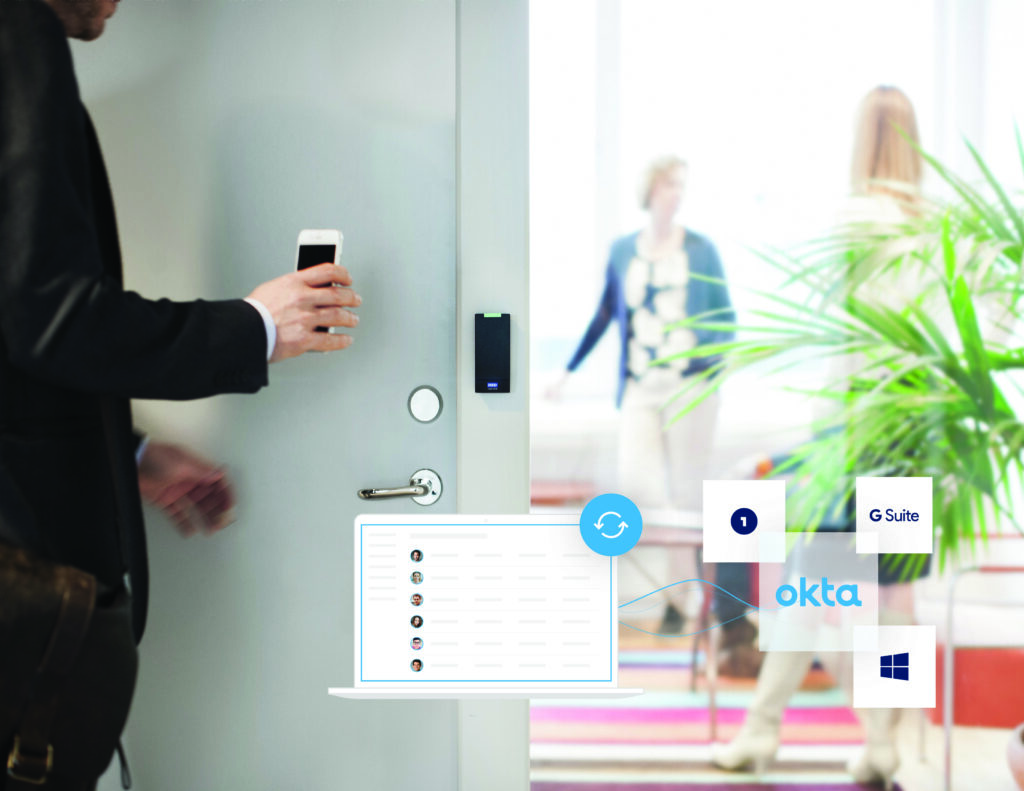The term enterprise access control is a misnomer in today’s security world. Once understood as a way of providing large-scale oversight to the physical premises of a corporation, enterprise access control is now taking on a new meaning. Mike Maxsenti, General Manager of Access Control at Genea, breaks down why enterprise access control is changing and how the security industry must redefine it.
Redefining Enterprise Access Control: Who Needs It?
The term “enterprise access control” probably does one of two things. It either drums up memories of Captain Jean Luc Picard manning the Starship Enterprise in Star Trek, or…TRIGGER WARNING…it makes you break out in cold sweats as you contemplate the corporate office environment.
While enterprise access control was (and often still is) more closely related to the corporate office environment, user demand is changing this idea.
“The whole notion of enterprise access control comes from a large corporate office environment,” Maxsenti explained. “With corporations changing their office strategies drastically over the past few years, what an enterprise access control system is and who uses it is changing.”
In fact, Maxsenti has found that organizations like K-12 schools districts, universities and manufacturing facilities require the most feature-rich systems. A university, for example, might need to create a variety of custom user groups for students, faculty and other staff members. With frequent change – such as students matriculating – these user groups must be dynamic yet efficient. They must allow IT and security teams to simultaneously make changes on a user-by-user basis while also providing the capability of making bulk adjustments. System admins must be able to automate their security processes yet make specific changes when necessary. Therefore, it’s helpful to have a system that bulk assigns general access privileges to cafeterias, meeting rooms and other common areas, while also having the option of assigning specific locations like dormitories or labs.
“It’s no longer good enough just to have door access groups. You have to be able to group users by department, title or other grouping modality,” Maxsenti said. “The customers that truly need an ‘enterprise’ system aren’t just enterprises anymore, and I think that’s going to be a really interesting change.”
Four Major Criteria of an Enterprise Access Control System
The term “enterprise access control” no longer solely applies to the corporate workplace. Instead, a more accurate way of labeling these feature-rich systems is multifunctional access control. Maxsenti categorized multifunctional access control systems within four major buckets:
- Core Features
- Integrations
- Infrastructure
- Support
Each of these categories represents a vital aspect of what access control customers are looking for.
Core Features in Multifunctional Access Control
The features of an access control system can vary tremendously. However, core essential requirements include scheduling, access groups, rule configuration and reporting. How well these core features are developed varies by provider, but the goals should always be the same: give the user a streamlined way of customizing how each feature works while providing general ways to automate. Let’s more thoroughly examine how these features increase productivity.
Custom Scheduling
Schedule customization enables the alignment of access privileges with employee roles, time-sensitive tasks and visitor access. For example, IT and security teams can specify time periods in which specific doors remain locked. In conjunction with features like user groups, administrators can schedule credentials of a specific group to unlock doors only at a specific time.
For instance, if Pete’s Peat Moss only wants to allow cashiers into their retail building between 8 a.m. and 6 p.m., then they can create that rule within their access control dashboard. If Pete’s wants to extend hours of access for their managers, they can accomplish this with custom scheduling, too. Custom scheduling helps admins establish office work patterns and empowers them to swiftly respond to security incidents.
Access Groups
As mentioned, access groups help automate the credential provisioning process. How? Instead of assigning credentials one user at a time, IT and security admins can create a user group with its own custom access privileges. For example, the “teachers” access group at a K-12 school may have different access privileges from the “custodial” access group.
But why is this helpful? By defining permissions, access is reserved for those that need it most, thereby protecting security. More advanced systems can assign and adjust user permissions in bulk as well.
Rule Configuration
Rule configuration takes automation a set further. Advanced enterprise access control systems might use “if this, then that” (IFTTT) rule configuration technology, a smart strategy for enhancing security and operational efficiency. With IFTTT, when specific conditions are met, predefined actions are triggered automatically.
For example, if an employee’s access card is used outside of regular working hours or in an unauthorized area, the system can instantly lock doors or send alerts to security personnel. This proactive approach not only deters potential security breaches but also reduces the need for constant human monitoring, saving time and resources.
IFTTT rules can adapt to evolving security requirements and ensure a responsive, intelligent access control system that safeguards physical assets and premises effectively.
Custom Reporting
“Another hallmark of an enterprise-class access control system is on the reporting side,” Maxsenti said. “You need to be able to do reporting that maps onto the organizational framework that applies to user groups.”
Collecting data helps IT and security teams take proactive steps towards bolstering their security. Custom reporting features deliver detailed information about door use, foot traffic and more, allowing teams to get granular with the data they collect. Genea allows admins to regularly receive PDFs of their access information delivered right to their email inbox.
“It’s not good enough just to keep a record of every time employees badge into a door,” Maxsenti said. “Customers need actionable data, giving them next-level insight into how people interact with their physical space.”
Custom reporting for physical access control is like a streamlined roadmap toward truly understanding your space. It provides tailored insights into facility access patterns and security events, enabling data-driven decision-making. Administrators can design reports that align with their unique security objectives, making it easier to identify anomalies, track access trends and assess security risks.
With all that said, Maxsenti still feels that there is an overemphasis on the “box-checking of features” within the security industry.
“Most companies today would take an Active Directory or Okta integration over mantraps,” Maxsenti said. “There are these obscure, rarely used features that integrators fixate on, that customers seldom care about.”
Enterprise Security Depends on Integrations
Industry leaders who provide enterprise access control have scrapped outdated, on-premises systems in favor of cloud-based access control. With the cloud’s flexibility, providers have found ways to give users an extremely customizable experience, especially when it comes to scheduling, access grouping, rule configuration and reporting.
But the cloud does more than make feature sets easily deployable. When used at its fullest potential, the cloud unites disparate systems in a “single pane of glass” solution. This invaluable benefit can save time and streamline processes not only for the IT department but the entire organization. Let’s look at a few of the integrations necessary in an enterprise access control system.
- Alert Integrations- Slack, Microsoft Teams, Cisco Webex
- Directory Integrations- Okta, Azure AD, Google Workspace
- Video Management Systems (VMS)- Arcules, Milestone, Cisco Meraki, Eagle Eye

Alert Notification Integrations for Enterprise Security
How users interact with the facilities, whether it be an office door or parking gate, informs IT and security teams of security vulnerabilities. However, recognizing this is only half the battle. Enterprise access control systems must be able to provide alerts. To accomplish this, providers integrate access control and alert notification software.
At their core, alert integrations notify users when an access event occurs or when a door goes offline. They assist with:
- Immediate Awareness– Alert systems are designed to detect unusual or unauthorized access events. When these events occur, the system sends instant notifications to security personnel.
- Timely Response– By receiving immediate alerts, security teams can take swift actions to mitigate potential threats.
- Reducing Response Time- Alert systems significantly reduce response time compared to traditional manual monitoring.
Directory Integrations
Directory service software, like Okta or Azure Active Directory, acts as a centralized repository of user identification. When integrated with cloud-based access control, administrators can manage user rights within a single interface, instead of switching between software platforms. As you can imagine, this saves time and strengthens security. Enterprise access control users also benefit from directory integrations by:
- Automating User Provisioning and Deprovisioning: Integrating directory systems automates the process of adding and removing users from access control systems. When a new employee is added to the directory, their access permissions are automatically synced with the physical access control system, ensuring they have the appropriate level of access from day one. Similarly, when an employee leaves or changes roles, their access rights can be promptly updated or revoked.
- Using Role-Based Access Control: Directory systems support role-based access control (RBAC). This means that access permissions are assigned based on an individual’s role within the organization. When integrated with physical access control, RBAC ensures that employees only have access to areas and resources necessary for their specific job functions. This minimizes the risk of unauthorized access.
- Authentication and Single Sign-On (SSO): Directory integrations enhance authentication for physical access control systems. Users can use their existing directory credentials to gain access, reducing the need for separate access control credentials. Single Sign-On (SSO) capabilities further simplify the user experience by allowing users to sign in once and access both IT resources and physical facilities without the need for multiple logins.
Video Management Systems
Video Management System (VMS) integrations with enterprise access control systems provide a holistic approach to security by enhancing surveillance, monitoring and control capabilities. Here’s how VMS integrations with platforms like Arcules, Milestone, Cisco Meraki, and Eagle Eye can help enterprise access control:
- Comprehensive Visibility: VMS integrations allow security personnel to have a comprehensive view of both video footage and access control events in a unified interface. This integration provides real-time monitoring of access points and helps in identifying potential security threats or anomalies.
- Enhanced Security: Integrating VMS with access control enables dynamic response to security incidents. When an unauthorized access attempt occurs, the VMS can trigger alarms, start recording, and display live video feeds from nearby cameras, allowing security teams to respond promptly.
- Event Correlation: VMS integrations can correlate access control events with video footage. This means that when someone uses a credential to enter a restricted area, the system can automatically retrieve and display the corresponding video.
VMS integrations with enterprise access control systems create a synergy that strengthens security measures, improves incident response and enhances overall situational awareness. This integration is a vital component of modern security infrastructure for organizations of all sizes.
Infrastructure: Building a Solid Foundation
Without the right infrastructure, scaling an enterprise system is costly. The main way to keep costs low when migrating or installing a new system is by choosing non-proprietary hardware. A non-proprietary enterprise system offers significant advantages for organizations seeking flexible and cost-effective security solutions. Unlike proprietary systems that lock users into a single vendor’s hardware and software ecosystem, non-proprietary systems offer a multitude of benefits.
Firstly, non-proprietary systems like Genea promote interoperability. They enable seamless integration with a wide range of access control hardware, cameras and security components. This compatibility ensures that organizations adapt and expand their security systems without being constrained by vendor-specific limitations.
One of the most compelling advantages is cost savings. A non-proprietary approach allows for access control software takeovers, meaning organizations can transition to other cloud-based providers without the need for costly hardware replacements. This results in substantial cost savings by reusing existing equipment, such as card readers and controllers.
Furthermore, non-proprietary systems empower organizations with freedom of choice, enabling them to select the best hardware and software components to suit their specific needs. This flexibility reduces vendor lock-in and enhances the long-term cost-efficiency of the security infrastructure.
Non-proprietary enterprise access control offers adaptability, scalability and significant cost savings. Read more in our case study with Sage Realty.
Don’t Overlook Customer Support
The fourth pillar of multifunctional access control is customer support. Traditionally, on-premises access control systems were sold through integrators. However, Maxsenti said more and more IT and security teams are wanting a direct line of communication with the system manufacturer.
“I’m noticing that there’s a mismatch between what integrators view as enterprise access control and what customers are looking for when it comes to infrastructure, integrations, support and their desire to have a direct relationship with the OEM (original equipment manufacturer),” Maxsenti said. “There’s a mismatch between what the integrators and consultants view as enterprise and what customers look for.”
Some access control system providers are finding opportunities to better serve their customers, implementing initiatives like 24/7/365 live support and online help resources centers. However, those providers with the best customer service will support the entire lifecycle – from implementation through use. Customers want more than just an access control manufacturer; they want a partner.
Multifunctional Security for Tomorrow
A partnership is what you get from Genea. IT and security teams enjoy the benefits of a dedicated customer support team, a cutting-edge platform and non-proprietary hardware. Best of all, users get a “single pane of glass” experience, so everything you need is available from one dashboard.
What You Get
- Integrations with many video management system (VMS)
- Robust and native visitor management system integration
- Non-proprietary Mercury hardware
- All-in-one web application
- 24/7/365 support
“The ‘single pane of glass’ initiatives are crucial for every kind of organization today because, especially in tighter economic times, IT and security teams are being tasked to do more with less,” Maxsenti said. “What ‘single pane of glass’ solutions do in these situations is allow security admins to secure more facilities and operate more systems, more efficiently.”
As customer needs and security requirements continue to change, so should the way we think about enterprise access control. Large organizations like schools, manufacturers and enterprises demand solutions that make their security nimbler even with reduced teams. Single pane of glass access control is one way the industry is delivering. However, only by excelling in each of the four criteria — robust core features, integrations, infrastructure and support – will physical security manufacturers truly stand the test of time.
For more information about how you can improve your security, contact one of our knowledgeable representatives



